Emilia Romagna is located between the coordinates 44° 30′ 38″ N, 10° 57′ 25″ E in northern Italy, stretching from the Apennine Mountains to the Po Valley and the Adriatic Sea. It is one of the wealthiest and most developed regions in Europe. Emilia Romagna has many different nicknames, including “The Food Valley,” “The Motor Valley,” and “The Land of Verdi,” after the famous composer Giuseppe Verdi, who was born there.
The capital and largest city of Emilia Romagna is Bologna. The current President of Emilia Romagna in 2023 is Stefano Bonaccini, who was re-elected in 2020. Geographically, Emilia Romagna is known for its contrasting landscapes, ranging from the beaches of the Adriatic Riviera to the peaks of the Apennines. Culturally, the region is famous for its food, art, music, and motorsports. Some of the most iconic foods and products of the region include Parmigiano Reggiano cheese, balsamic vinegar from Modena, and luxury sports cars like Ferrari and Lamborghini.
Where is the Emilia Romagna region located in Italy?
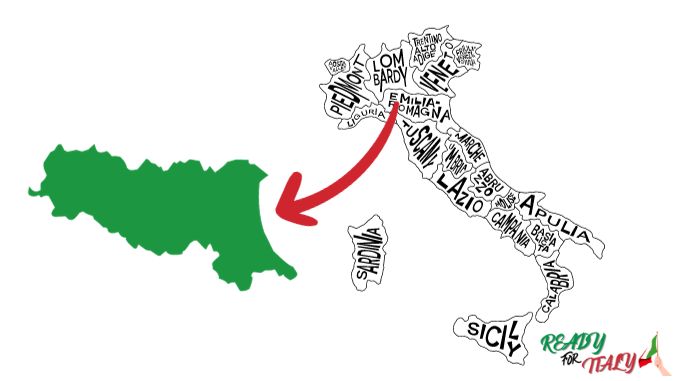
The Emilia Romagna region is located in northern Italy, part of the north-central section along with Lombardy and Veneto. It stretches across nearly 9,000 square miles from the Apennine Mountains in the south to the Po River basin in the north.
Emilia Romagna shares borders with five other regions of Italy. To the west lies Piedmont and Liguria along the upper Po Valley. To the south sits Tuscany and Le Marche along the Apennine mountain range. And to the east along the Adriatic Sea are Veneto, the Republic of San Marino, and Le Marche. Its strategic location makes it easily accessible and a crossroads between northern and central Italy.
As part of northern Italy, Emilia Romagna benefits from its proximity to major cities like Milan, Florence, Venice, and Rome. It also borders Switzerland to the north. The region contains Italy’s longest highway, the A1, connecting it from Milan to Naples. The major international airport is Bologna Guglielmo Marconi Airport, providing flights around Italy, Europe, and Intercontinental.
With high-speed rail lines and developed infrastructure, Emilia Romagna has prospered in tourism and exports due to its prime geographic location in northern Italy. Its access to the Po River and the Adriatic also made it an important agricultural and industrial center historically.
What is the population of Emilia-Romagna?
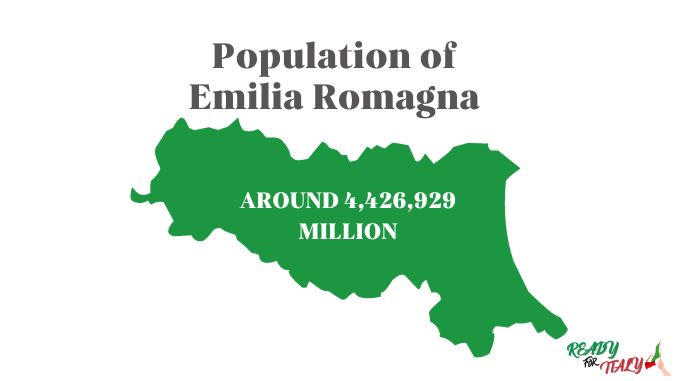
Emilia-Romagna has a population of around 4,426,929 million as of 2023, making it among the most populous region in Italy. The population density is about 196 inhabitants per square kilometer. The population has climbed gradually over the decades, with positive growth rates between 2-5%, according to statistics.
The largest metropolitan area is around the capital of Bologna, with over 1 million residents. Modena, Parma, Reggio Emilia, Ravenna, Rimini, and Ferrara are other large cities in the range of 100,000 to 200,000 people. About two-thirds of the population lives in urban areas.
According to the official website of Emilia-Romagna, the Italian region receives over 11.5 million visitors annually, making it one of the top tourist destinations in Italy. People come for the beaches of the Adriatic, cultural cities like Bologna, automotive destinations like Modena, and food/wine tourism around Parma and Reggio Emilia. The influx of tourists, especially in summertime, effectively doubles the population along the coastal areas.
Emilia Romagna Map
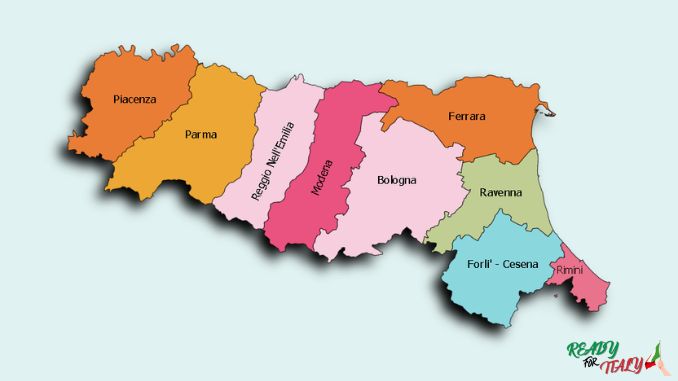
What are the Geographical features of Emilia-Romagna?
Emilia Romagna covers an area of more than 22,000 square kilometers. Geographically, it can be divided into three zones: the mountainous Apennines, the Po Valley basin, and the Adriatic coastal plain.
The Apennine Mountains cross the southern part of the region, including the highest peak of Monte Cimone at 2165 meters. The range creates a natural border with Tuscany. These mountains have cooler temperatures and are more rustic, with small villages and ski resorts.
The Po Valley makes up the northern section and is a broad, flat plain. Much of the agriculture, industry, and manufacturing occurs here along the Po River, Italy’s longest. The valley stretches into Lombardy and Veneto, creating an interconnected industrial hub. Major cities like Bologna, Modena, and Parma are in this valley.
The Adriatic coastal plain runs along the eastern edge of Emilia Romagna along the azure waters of the Adriatic Sea. Known as the Riviera Romagnola, the coast has long sandy beaches dotted with seaside resort towns like Rimini, Riccione, and Cattolica. The coastal climate is milder than inland.
So Emilia Romagna truly has diverse landscapes, from the peaks of the Apennines to the waterfront along the Adriatic. This variety is part of what makes it such an interesting region to explore.
What to Visit in Emilia Romagna?
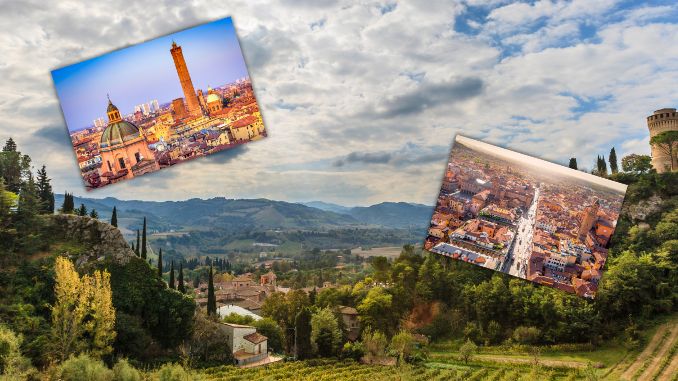
From ancient history to modern motorsports, Emilia Romagna has many attractions and sites to discover. Here are some of the top places to visit:
Bologna: The capital city has one of the oldest universities in Europe, lively student culture, and great nightlife. Some others attractions are: Climb the medieval Asinelli Tower for views of the red-tiled rooftops. See masterpieces at the Pinacoteca Nazionale di Bologna gallery. Sample local cuisine like Bolognese meat sauce and mortadella.
Ferrara: This Renaissance city has a historic center named a UNESCO World Heritage Site. The Castello Estense is an imposing medieval castle with a moat and lookout towers. Or you can take a bike ride through the city streets and appreciate the architecture.
Parma: Admire the stunning frescoes and paintings inside the Camera di San Paolo. Sample Parmigiano Reggiano cheese and Parma ham – famous local delicacies. Look for the graphic novels by local artist Giovannino Guareschi featuring priest Don Camillo.
Modena: The 12th-century Modena Cathedral is a stunning Romanesque building with elaborate carvings. In Modena you can Visit balsamic vinegar makers to taste the special Modena variety, aged for years. Check out the Enzo Ferrari museum to learn about the famous Italian race car driver from Modena.
Ravenna: This city has a remarkable collection of early Christian mosaics dating back to the 5th century AD. You can admire mosaic masterpieces inside the Basilica di San Vitale and other sites. Relax at one of Ravenna’s beaches along the Adriatic after exploring the mosaics.
Rimini: Stretching down the coast from Rimini are miles of beaches with fun summer resort towns. Rimini’s Roman past can be seen in the Arch of Augustus and the Surgeon’s House ruins. Enjoy nightlife at the hundreds of bars and clubs, especially as the summer beach season gets going.
Motorvalley: Car lovers of all kinds will enjoy the museums dedicated to legendary brands like Ferrari, Lamborghini, Maserati, Pagani, De Tomaso, and Ducati. The Casa Natale Enzo Ferrari Museum in Modena celebrates the life of the automaker. Tour the Ferrari factory in Maranello to see where these iconic sports cars are made.
Appennino Tosco-Emiliano National Park: Hike through the forests and mountains of the Apennines in this protected area. See medieval castles dotting the landscape, like the Castle of Canossa. Go skiing in the winter at resorts like Monte Cimone, Cerreto Laghi, and others.
What are the most Famous Cities in Emilia-Romagna?
Emilia Romagna contains many fascinating cities to explore, known for architecture, art, history, and culinary traditions. Based on tourist visits, these are among the most popular cities:
Bologna
As the regional capital and largest city in Emilia Romagna, with a population estimated at 814,332 residents, Bologna receives over 3 million tourists annually. The historic university city has a well-preserved medieval center with elegant piazzas and art-filled churches. Visitors can enjoy browsing the bustling Quadrilatero market district, climbing the iconic Asinelli and Garisenda towers, and sampling traditional Bolognese cuisine like tortellini in Brodo and tagliatelle al ragù.
Rimini
With an estimated population of 157,356, according to worldpopulationreview.com, Rimini attracts over 10 million tourists yearly as the core beach destination on the Adriatic coast. In summer, its lively boardwalk is packed with beach-goers enjoying the sun, fresh seafood, and vibrant nightlife along the marina. Rimini also has important Roman ruins like the Arch of Augustus and a Renaissance old town center with works by native son, filmmaker Federico Fellini.
Ravenna
Home to some 160,262. residents, Ravenna draws over 1 million visitors annually to admire its remarkable collection of 5th and 6th-century mosaics and Byzantine-era monuments like the Basilica of San Vitale. These brilliant mosaics display exquisite craftsmanship and artistry inside the city’s churches and baptisteries. Ravenna’s proximity to the beaches of the Adriatic Sea is another draw for tourists.
Modena
With around 361,215 inhabitants, Modena is the birthplace of famous Italian sports car brands like Ferrari, Lamborghini, and Maserati. It attracts over 1.5 million visitors eager to tour the Enzo Ferrari museum or visit the factories of these luxury automakers nearby. Modena is also acclaimed for its balsamic vinegar, which is considered one of the best in the world.
Parma
Parma lures over 300 thousand gastronome tourists annually to its nearly 333,695. residents. Visitors come to taste authentic Parmigiano Reggiano cheese, Prosciutto di Parma ham, and other culinary specialties. The elegant city also captivates guests with its Correggio paintings, stunning countryside vistas, and medieval architecture.
Piacenza
In Piacenza, which has around 104,874 inhabitants, approximately 500,000 tourists visit each year. They come to explore this charming historic town known for its grand medieval arcades, elegant Renaissance palaces, imposing Baroque churches, and the Gothic town hall. Piacenza is also prized for local wines and foods like coppa, pancetta, and Gorgonzola cheese.
Cesena
Midway between Ravenna and Rimini lies Cesena, home to about 97,257 people. Over 300,000 tourists visit Cesena annually to see Malatesta-era fortresses, Renaissance villas, and the art-filled Cesena Pinacoteca museum. Cesena also boasts good beaches along the Romagna Riviera and energetic nightlife.
Ferrara
With its population of 132,020, Ferrara sees over 500,000 tourists yearly who come to appreciate its intact medieval center and Renaissance-era additions. The iconic Castello Estense castle, with its moat and towers, dominates the landscape. Ferrara’s Cathedral has elaborately carved Biblical scenes, and its bicycle-friendly streets are captivating.
Forli
Situated near Ravenna, Forli is home to 118 250 residents and hosts around 300,000 visitors annually. Tourists enjoy architecture like the San Mercuriale Basilica, the Abbazia di San Mercuriale, museums, restaurants, and the lively ambiance of this charming town.
Reggio Emilia
The last city discussed, Reggio Emilia, has a population nearing 376,024 Approximately 150,000 tourists come each year, drawn by sights like the Basilica della Ghiara and the beauty of the typical Emilia countryside. Reggio Emilia also has a reputation for making some of the best Parmigiano Reggiano cheese.
What are the safest cities in Emilia Romagna?
According to TripAdvisor crime statistics, the following cities in Emilia Romagna are considered the safest:
- Ravenna is the safest overall, with low rates of crime, violence, and petty theft. As a small city off the beaten path, Ravenna remains tranquil and secure.
- Forli has very low crime rates, especially regarding violent crimes and robberies. Its provincial character helps keep crime rare.
- Ferrara comes in as one of Italy’s safest large cities, thanks to vigilant law enforcement and many surveillance cameras. Violent and property crimes are a rarity.
- Rimini has beefed up security and police presence in recent years due to its popularity. This has led to big improvements in safety for tourists and residents.
- Parma enjoys a reputation as a very safe city, with violent crime and assaults almost unheard of. The historic center is heavily monitored with security cameras.
What are the most dangerous cities in Emilia Romagna?
While no cities in Emilia Romagna could be considered truly dangerous, some do see slightly higher crime rates based on available data:
- Modena has the highest overall crime rate in the region due to its size, wealth, and black market presence. However, violent offenses are still rare.
- Bologna sees more crime than other Emilia cities, focused on areas popular with students and tourists. Still, violent crime is minimal.
- Piacenza shows higher rates of petty crimes like pickpocketing and purse snatching, especially at its train station. Additional police patrols aim to curb this.
- Cesena has more car thefts and break-ins than other cities in the region, though authorities continue safety efforts.
- Rimini has worked hard to shake a reputation for petty crimes in its crowded beach areas. Millions of tourists each year evidence that most safety concerns are minimal.
What is the Best Time to Visit Emilia Romagna Region in Italy?
Emilia Romagna’s climate and tourist season varies across the region, from mountains to plains to coastline. Here are some recommendations on the best times to visit:
- Summer (June to August) is the peak season in coastal areas like Rimini, Riccione, and Cattolica, when the beaches become lively. Inland cities slow down as locals escape the heat.
- Late spring (May) and early fall (September/October) see pleasant weather. Hotel rates drop from summer highs, but there are smaller crowds.
- Winter is quiet, with closures along the coast. But Christmas markets create holiday ambiance in cities like Bologna. For ski fans, the Apennines offer runs.
- Bologna, Modena, and Parma have mild weather and open attractions year-round for sightseeing. However, student-fueled Bologna quiets in August.
- Autumn has harvest time festivals like the Festa del Raccolto potato festival in September. Truffle and mushroom hunting seasons also begin in the fall.
So, in summary, May, September, and October are good times for sightseeing, nice weather, and lower prices. July/August for beaches, June/July for music festivals, and winter for skiing or Christmas magic.
What are the traditional foods of Emilia Romagna?
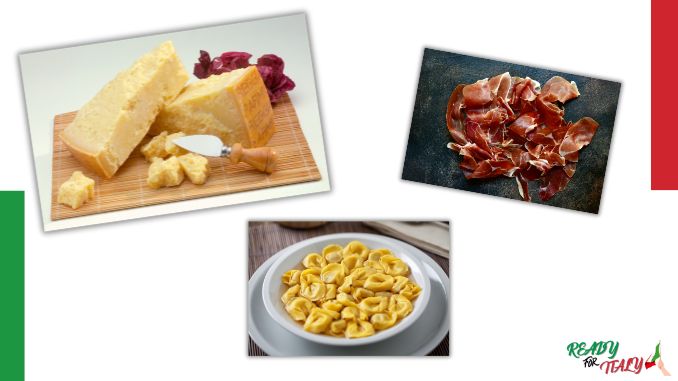
Emilia Romagna is considered one of Italy’s greatest food regions. Some iconic traditional foods and products include:
Parmigiano Reggiano Cheese: This “king of cheese” comes from Parma and Reggio Emilia. Made for over 600 years, it’s an aged, granular cow’s milk cheese with a hard rind and complex, nutty flavor.
Balsamic Vinegar: The artisanal balsamic vinegar of Modena has a syrupy texture and a concentrated, sweet-sour taste. It’s aged for years in wooden barrels.
Prosciutto di Parma: Parma’s cured ham is famous worldwide for its distinctive taste. The pork leg is salted and air-dried for over a year in the hills around Parma.
Traditional Bolognese Sauce: A meaty, slow-simmered tomato sauce with pancetta, beef, red wine, and cream – tossed through tagliatelle pasta.
Piadina Flatbread: A crispy flatbread made with white flour, lard, or olive oil and often filled with cheese or meats. Popular in Romagna.
Culatello di Zibello: Considered the finest prosciutto, this dense, buttery ham comes from around Parma and ages up to 3 years.
Tortellini: These small pasta parcels stuffed with pork and Parmesan are a specialty of Bologna and Modena. Served in rich capon broth.
Passatelli in Brodo: Little breadcrumb dumplings in a Parmesan-enriched meat broth. A warming Emilia Romagna classic.
Zampone and Cotechino: Hearty sausages are made by stuffing a pig’s trotters or cotechino sausage with minced pork and spices. Winter fare.
Aceto Balsamico Tradizionale: The “king of balsamic” aged at least 12 years and only produced in tiny amounts using local grapes like Trebbiano and Lambrusco.
What are the most famous Emilia-Romagna wines?
Emilia-Romagna produces many excellent Italian wines. The most famous include:
Lambrusco: It is a sparkling red wine with flavors of cherry and blackberry. The most widely produced wine in Emilia. Sangiovese di Romagna: The Romagnola variety of the Sangiovese grape makes elegant, medium-bodied reds. Albana di Romagna: A crisp, light white made from the Albana grape. Often made into a passito dessert wine with peach and apricot notes. Others important wines produced in Emilia Romagna are: Pignoletto,Trebbiano, Barbera, Bonarda, Gutturnio, Malvasia, Pagadebit di Romagna, Sangiovese di Romagna Superiore Riserva, Colli Piacentini Gutturnio Riserva, Colli di Parma Malvasia, Colli Bolognesi Classico Pignoletto, Reggiano Lambrusco, Bosco Eliceo Fortana, Colli di Imola Vino Nobile.
Emilia Romagna’s long winemaking tradition provides a range of excellent wines to sample, from Lambrusco to Sangiovese to obscure local gems. Any visit to the region should involve vineyard tours and tasting rooms.
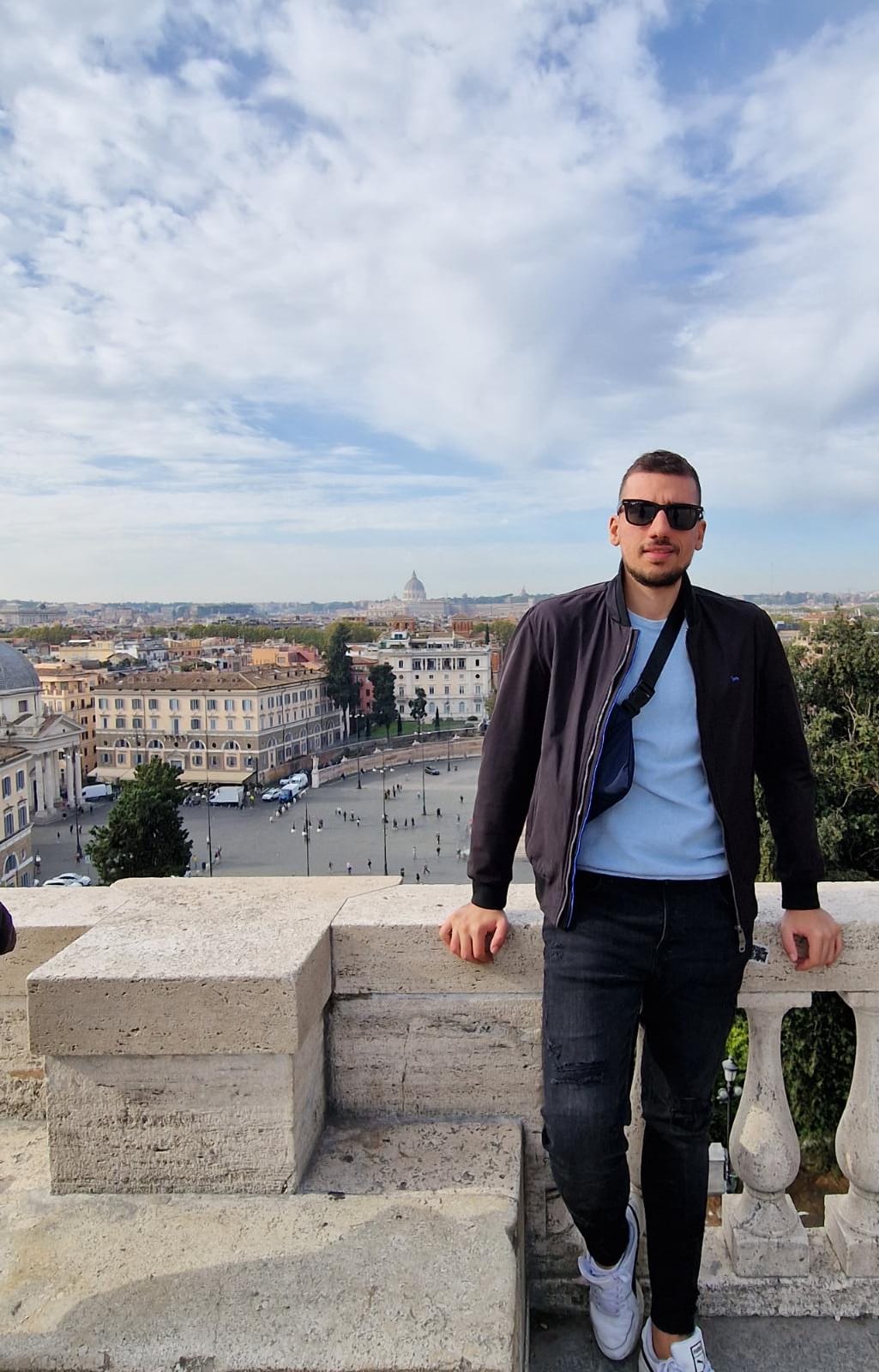
Hey, I’m Giovanni, an Italian that lives in Italy and the author of this website! I started this website because I like to travel, discover new places and share my knowledge about Italy with more people worldwide. I love writing about everything regarding Italy, its culture, history, and lifestyle. I hope you found value in whatever article you read, and if you have any remaining questions, don’t hesitate to contact me!
